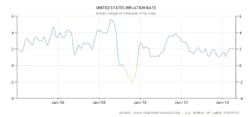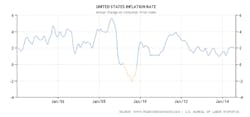Can Deflation Forever Be The Norm For Passive Components?
In simple terms, deflation is a decrease in the general price level of goods and services, a trend that increases the real value of money over time. In contrast, inflation is a sustained increase in general price levels over a period of time, a trend that reduces the real value of money. Even more simply put, during a deflationary period one is able to buy more for their money, and during an inflationary period, less.
Those of us making a living manufacturing and/or selling passive components—capacitors, resistors, inductors, ferrites, and so forth—well know how deflation works. Though the norm in the world around us is an increase in the prices of the things we buy, the price of the things we sell for a living trends in the opposite direction.
To put these differences in pricing behavior in “real money” terms, let’s take a look at price trends for a variety of common staples and a few of the metals common to passive components. To keep this current and relevant, we will limit our look to median change in prices over the last 10 years, using data from the Bureau of Labor Statistics and the U.S. Geological Survey.
- U.S. Electricity per KWH: +46%; climbed steadily right through the recession
- Bananas per pound: +20%; leveled off after the recession
- Milk per gallon: +14%; leveled off after the recession
- Gasoline per gallon: +90%; dropped $0.80/gal during the recession but gained since
- Copper per metric ton: +331%; peaked in 2011 and held relatively steady since
- Nickel per metric ton: +82%; same trend as copper; saw volatility as high as 151%
- Rare Earth Metals per metric ton: +733%; big jump in 2011 with 1,394% swing
Figure 1 shows the overall inflation rates in the U.S. economy for the past 10 years. Note the climb going into the recession, followed by a sharp correction. For the past couple of years, inflation has held at a steady 1% to 2% growth rate.
Source: www.Tradingeconomics.com, US. Bureau of Labor Statistics
Now, for something completely different, let’s take a look at average selling price (ASP) trends in TTI’s North America passive components business.
TTI is the leading distributor of capacitors, resistors, and electromagnetic (inductors, ferrites, and so forth) components in the country, and as such is the largest distributor for the leading manufacturers of these components—companies such as Vishay, Kemet, AVX, and Murata. For years, we have closely tracked ASPs of these parts, all the way down to a package type/size and dielectric level. We literally sell billions of them a year, and so we have a very large data set to study. But we don’t need to go that deep to clearly see the trend in prices over the last 10 years.
Capacitors, overall, have been particularly hard hit; some dielectrics less so than others, but even the newer technologies such as polymers have experienced ongoing deflation. Looking at TTI’s total capacitor ASP trend reveals significant price erosion to the tune of 56% since 2004. And this has happened in spite of the fact that unit sales of the higher ASP part of the product mix (for example, aluminum, electrolytic, film, and polymer) are growing faster than that of commodity ceramics and tantalums.
Last year alone, we experienced a 15% decline in capacitor ASPs. But that was nothing compared to the 24% year-on-year drop during the recession. This year, overall capacitor average selling prices have dropped below 3 cents.
The deflation in resistors the past 10 years hasn’t been quite so severe. ASPs have dropped 26% during this time, but the year-on-year decline has slowed. Last year, we saw only a 5% drop, which was much better than the 24% drop we experienced during the recession (identical to capacitors.) Today’s average selling prices for resistors are half that of capacitors— despite the fact that we are far and away the largest sellers of mil spec resistors that sell for 100 times or more our commercial resistor ASP.
Price erosion in our electromagnetic (EMC) product set has ridden a descending line midway between that of caps and resistors. We only began tracking this product set in 2008, but in that time we have seen a 35% decline in ASP. The past couple of years have been particularly bad, with a 15% and 17% decline in 2012 and 2013, respectively. Overall ASPs are just below 17 cents today.
All of these components are the fundamentals of any electronic circuit, and are by far the most populous in any piece of electronic equipment. The majority of them are true commodities that follow industry standards and are available from multiple suppliers. It is that fact that is most readily cited as the basis for deflation in these parts. But it is interesting to note that this hasn’t held true for non-component commodities such as bananas and milk.
You could probably write a book about the dynamics and unique challenges of the passive component business. That’s not something I plan to attempt, but I will leave you with an observation:
The objective of any for-profit business is to sell goods and/or services for a price higher than it costs the seller to produce or procure them. It stands to reason that ASPs won’t fall to zero— thankfully, for in the absence of profit there won’t be any manufacturers or sellers of these parts. And because these parts are fundamental to the greater electronics industry, the customer base would struggle to survive even a partial extinction of the passive component supply base
At some point, the inflation that is happening in the larger world around us will also take hold of the smaller world of passive electronic components. We are already seeing hints of that in resistors. End product pricing models that are predicated on quarter-on-quarter component pricing declines will need to be revised, probably sooner rather than later. This stuff isn’t gold or diamonds, but it is at least milk and bananas.








